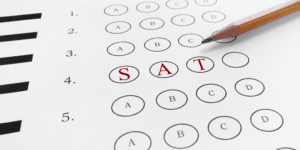Many students who’ve decided to take the GMAT for business school break out into a cold sweat when faced with the prospect of studying math for the Quantitative section of the GMAT. Let’s face it—you may not have taken a math class since high school, and at this point you’re struggling to remember the formula for the area of a circle! Well, fear not. This brief overview of GMAT math questions will help to allay your jitters, and we’ll also let you know how to set up your GMAT math prep and offer some sources for GMAT sample math questions as well.
GMAT Math Content
The actual content of GMAT sample math questions does not extend beyond high school math up to the level of Algebra 2. There is no trigonometry or calculus. Refer to a few GMAT sample math questions to get a feel for the section, and peruse the list of covered concepts below to get a clearer picture of what you’re up against.
- Algebraic equations and inequalities
- Arithmetic, including decimals, percents, ratios, and number properties
- Exponents and square roots
- Geometry and coordinate geometry
- Number lines and absolute value
- Variable operations
- Word problems
- Combinatorics, including probability, combinations and permutations
- Data analysis
Incorporate GMAT Math Questions into your GMAT Math Prep
The format of GMAT math questions consists of two types: Data Sufficiency and Problem Solving. The two question-types are interspersed in a single 62-minute quantitative section. About 25 to 35 percent of the questions are Data Sufficiency, with the rest being Problem Solving. Your GMAT math prep should include ample coverage for both.
- Data Sufficiency are multiple choice questions that come with two statements of data.
- The student must assess whether or not the statements provide sufficient data to answer the question.
- Then the student has to decide whether one or both statements, by themselves or together, provide enough information to answer the problem.
- Successful GMAT math prep comes from assaying many GMAT math sample questions.
- The key is often NOT to carry the problem through to a solution but rather simply to assess if there is enough information to arrive at a solution, thereby saving precious time.
- Problem Solving questions are multiple-choice questions that test the above listed high school math skills.
- These questions are much more straightforward than Data Sufficiency questions. They are like the more traditional questions you’ve seen on other standardized tests.
- Problem Solving questions take the form of standard multiple-choice problems, with 5 potential answer choices for each question.
- Your GMAT math prep should involve strategies that take advantage of this format, such as plugging in for variables, picking “smart” numbers, and plugging those answers back into the question.
- Also, you are not allowed a calculator on the GMAT Quantitative section, so be prepared to find calculation shortcuts in your GMAT math prep.
Question Adaptive Testing and GMAT Math Prep
Unlike almost any other standardized test you have taken, the GMAT is unique because it is a computer adaptive test. What’s more, it is adaptive by question, which means that you must answer each individual question before you can move on to the next one. Further, this means that you cannot return to questions, an element that greatly affects your GMAT math prep.
Get Help from the Pros
Want to learn more about the GMAT Quantitative section and how we can help you master it? Give us a call today!




